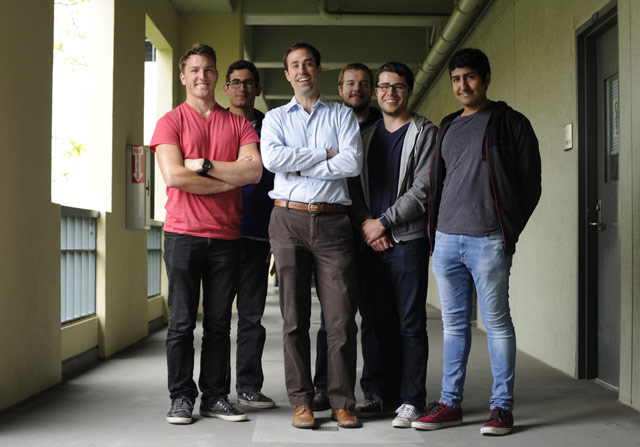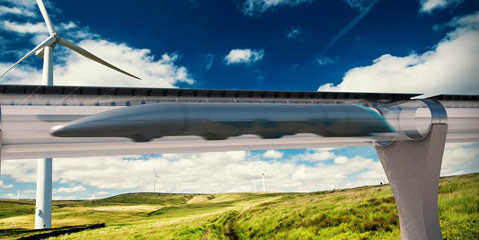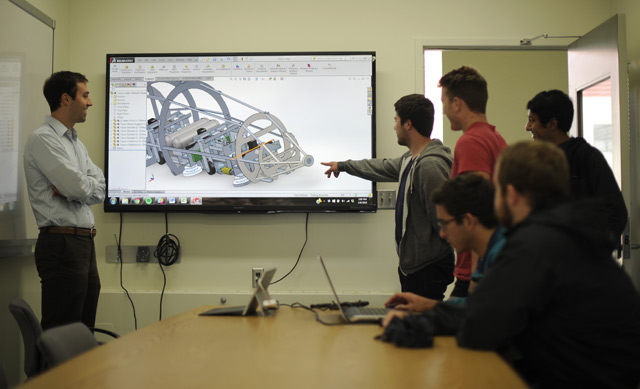UCSB Hyperloop Team Finalists in Worldwide Competition
Crew of Undergrads Helping Write Next Chapter of Transport History

Like many space junkies and budding engineers around the globe, Trevor Fritz follows SpaceX very closely, so he watched in awe on April 8 as the company successfully landed a reusable rocket on a barge in the middle of the Atlantic Ocean, a major milestone for interstellar exploration. Fritz, a UCSB mechanical engineering undergrad, hopes to be part of another SpaceX history-making venture. He is part of a university team competing to revolutionize travel here on Earth.
SpaceX founder Elon Musk — the big-brained entrepreneur behind PayPal and Tesla Motors — announced a competition for college students to design levitating passenger pods for his proposed Hyerloop project, a new mode of solar-powered, high-speed travel that would hurtle riders through vacuum tubes at 700 mph. Musk had come up with the idea a couple of years ago while he sat in Los Angeles traffic but said he was too busy with his electric car and private space companies to pursue it.
“Short of figuring out real teleportation, which would, of course, be awesome (someone please do this), the only option for super fast travel is to build a tube over or under the ground that contains a special environment,” Musk wrote in his white paper on the subject. If the Hyperloop were built along Interstate 5 in California, he said, it would cut travel time between L.A. and San Francisco to 30 minutes, cost much less than a high-speed rail ($6-$10 billion compared to $60 billion), and boast a range of ecological benefits, like reduced gas consumption and car emissions and overall less energy per passenger. Musk termed it a “fifth mode” of transport — after cars, planes, trains, and boats.

The response was huge. More than 1,200 teams entered the design contest, and after a few elimination rounds, including final judging at Texas A&M in January, only 30 remain. UCSB’s is one of them, alongside crews from MIT, Virginia Tech, UC Berkeley, the Netherlands, and Germany. “It was definitely amazing,” agreed Fritz’s teammate Sarah Conley. The UCSB group were certainly underdogs, with less funding, experience, and resources than many of the other schools. Now, they’re building their proof-of-concept pod, which will race this summer down a one-mile track being constructed by SpaceX near Hawthorne, California.
The team is made up of around 30 students, divided into subcommittees that focus on aerodynamics, levitation, structure, integration, and computer engineering. It’s overseen by faculty and graduate student advisors, who offer support but stay pretty hands-off. “My role is a facilitator,” said Faculty Advisor Tyler Susko. It’s up to the students to communicate and collaborate, like they’ll do out in the real world. “I’m trying to develop engineering leaders who will kick butt when they graduate.”
During the trip to Texas A&M, the UCSB team quickly discovered that the design for their 14-foot, 500-pound pod is significantly simpler, lighter, and less expensive than those of their competitors. Most of the other pods will weigh more than 1,000 pounds and cost more than $100,000 to build. Some feature elaborate passenger chambers and interior lighting. UCSB is working with a budget of $50,000-$60,000. “We kept repeating three words to ourselves,” said Fritz: “Affordable, realistic, and robust,” and, of course, safety. “We don’t want to be the team known for destroying the SpaceX track,” he explained.
Two students have been working on financing the self-funded project, which is already sponsored by a number of engineering and tech companies, including Raytheon, Northrop Grumman, and Ingersoll Rand. Recently they launched a crowdfunding page to help pay for some of the pod’s pricier items, such as six magnetic levitation engines that go for $5,000 a pop. The engines, powered by lithium polymer batteries, will levitate the steel and fiberglass pod 6mm above the aluminum base of the tube. It’ll be fitted with an array of sensors, and the whole system will be controlled by the team’s self-made circuit board.

Fritz grinned a little mischievously when he explained the team’s proof-of-concept pod is designed to reach speeds of 218 mph on the test track, faster than any other competitor. It’ll accelerate at 2 Gs (thrust forward at first by the track’s “pusher”) and stay at top speed for only three seconds before hitting the brakes. Judges will score each pod based on velocity, aerodynamics, overall performance, and so on. Prizes for the winners have not yet been announced, but the UCSB crew agreed fame and bragging rights are what they care about the most.
As the spring quarter begins, the undergrads, who are also carrying full class loads, are toiling long hours, breaking every once in a while for pizza and beer. They’re hammering out final designs and beginning fabrication in a machine shop near the UCen. “There are lots of meetings to keep everyone in the loop,” said Conley. “No pun intended.” Two SpaceX advisors speak with the team regularly, giving advice and signing off on all designs. “SpaceX has been amazing,” said teammate Celeste Bean. “They’ve given a bunch of 20-year-olds the opportunity to run a start-up, because that’s basically what this has turned into.”
Bean said she’s planning on graduate school next fall for computer engineering with a focus on controls. “This project really pushed me in that direction,” she explained. Conley is weighing her options. She’s interested in Engineers Without Borders and a possible internship with Northrop Grumman, and also mused, “Tesla would be awesome.” Fritz is headed to Vandenberg Air Force Base after graduation to help SpaceX retrofit its launch pad for a bigger rocket.
Susko thought that perhaps the biggest motivation for the students has been to be part of a “‘Wright brothers’ moment, to come up with a completely new mode of transportation.” A Hyperloop connecting Slovakia to Vienna and Budapest is already under discussion, so it’s only a matter of time before Musk’s dream becomes reality. We will see pods moving passengers at the speed of sound to and from all corners of the world, Susko believes. “Then these students can say, ‘I was one of the first people to work on it.’ How cool is that?”
To help sponsor UCSB Hyperloop, see tilt.com/tilts/hyperloop-funding



